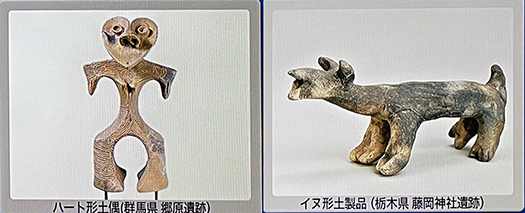


弥生と縄文って必ずしも非連続的というものではない印象を持つ。
それは弥生期の「自画像」痕跡が多数、土器に描かれたり
木版に彫り込んだり、粘土で造形されたりものを見て感じる。
また中国での日本列島記録初見とされる魏志倭人伝に「黥面」文化が書かれるが
その題材となった風習の証拠痕跡もこうして残っている。
習俗としてのこのような「文化」はやはり根強く存在したのだろう。
〜帯方郡より女王国に至る万二千余里。男子は大小と無く、皆黥面文身す。
古より以来、其の使、中国に詣(いた)るや、皆、自ら大夫と称す。
夏后少康の子、会稽に封ぜられるや、断髪文身し、以て蛟龍の害を避く。
今、倭の水人、好みて沈没して魚蛤を捕へ、文身し、亦、以て大魚水禽を厭(はら)ふ。
後、稍(やや)以て飾りと為す。諸国の文身、各(おのおの)異なり、
或は左に、或は右に、或は大に、或は小に、尊卑の差有り。
其の道里を計るに当に会稽の東冶の東に在るべし。〜(魏志倭人伝)
海人族的な風俗であるのか、犯罪者への刑罰的な意味なのか。
記紀の記述などを見ると、その後の支配者層にはその風俗はなかったようだ。
逆に言うと、列島人の基本的な感覚の中に上の写真やイラストのような
表現を許容する精神性が存在していたように思う。
弥生と縄文は文化性として併存していたので、こういう
キッチュな表現にその影響が色濃く残っていたのだろう。
こういう表現力というのはやはり「海洋民族」という素性を見せている。
環太平洋圏の北米南米、そして東南アジアの諸民族との親和性。
けっして大陸文化的な画一性には染まりにくい精神性が
日本列島人の基底的な「文化動機」に近しいように思える。
縄文土器、土偶とも通底する精神性が明らかなのではないか。
その後の時代の仏教寺院の縁起絵巻に表現される「鳥獣戯画」や
さらに現代に隆盛しているマンガ文化まで延々と日本人に受け継がれている。
もし日本文化が世界共通性を獲得していくとすれば、
その最大の文化資産はマンガ文明ではないかと個人的に思っている。
直感的視覚的表現力において日本は際だっている部分がある。
縄文・弥生の人びとのこういう表現力からは強いパワーを感じる。


さて本日朝のわが家前の積雪状況。
本格的な積雪感はまだ感じませんが、そこそこの積雪。
北国人は久しぶりに見る光景にしずかな感情を抱かされます。
いろいろな感情がそこで一旦ストップするみたいな雪のパワー。
この「淡々と受け入れる」季節感がまるで「洗礼」儀式のようでもある。
多忙な日々が訪れていますが、静かに受け止めていくしかありません。
English version⬇
Jomon – Yayoi Familiarity with Expressionism: The 37,000-Year History of the Japanese Archipelago – 31
The unique cultural customs and original expressions of the archipelago people described in the Wei-Shi-Wa-jin-Den. The Maritime Ethnicity Leading to the Manga Culture? …
I have the impression that the Yayoi and Jomon periods are not necessarily discontinuous.
It is that many traces of Yayoi “self-portraits” were painted on earthenware, carved on woodblocks
carved into woodblocks, or sculpted in clay.
In addition, the culture of “Paintings with a facial tattoo” is mentioned in the Wei Zhi Wajinden, which is said to be the first record of the Japanese archipelago in China.
There are also traces of evidence of the custom that became the subject of this culture.
This “culture” as a custom must have existed strongly.
〜From Obihang-gun to Queen-no-kuni, a distance of more than 12,000 ri. Every male, large or small, has a tattooed face and body.
Since ancient times, when their envoys came to China, they all called themselves “Da Fu.
When the son of Shaokang, the Empress of the Xia Dynasty, was appointed to Huiyue, he had his hair cut off and his body styled to avoid the danger of rain dragons.
The Japanese sailors of today prefer to sink to catch clams and clams, and they are also averse to large fishes and fowls.
Later, they were used as decorations. The body of each country is different.
Some are to the left, some to the right, some are large, some are small, and there are differences in respect.
The distance to the east of Dongji in Haeguei should be the best place to start. 〜(Wei Zhi Wan Dian)
Is this a custom of the Kaijin tribe, or is it a punishment for criminals?
According to the descriptions in Kiki and other sources, it seems that the ruling class did not have such customs after that time.
On the contrary, it seems that there existed in the basic sense of the archipelago people a mentality that tolerated expressions such as those in the photos and illustrations above.
I think there existed a mentality that tolerated such expressions as the above photos and illustrations in the basic sense of the archipelago people.
The Yayoi and Jomon cultures coexisted, and this kind of
The Yayoi and Jomon cultures coexisted, and the influence of their culture on the kitschy expressions of the Yayoi and Jomon was strong.
This kind of expressive power shows the nature of “maritime peoples.
This kind of expressive power shows the nature of a “maritime people,” and the affinity with the peoples of North America, South America, and Southeast Asia in the Pacific Rim.
A spirituality that is never easily tainted by continental cultural uniformity.
The Jomon people seem to have a spirituality that is not easily imbued with continental uniformity, which is close to the basic “cultural motivation” of the Japanese people.
The same spirituality is evident in Jomon earthenware and clay figurines.
The “Birds, beasts, and caricatures” expressed in Buddhist temple auspicious scrolls of later periods, as well as the “Manga culture” flourishing in modern times, are also clear examples of this spirituality.
The Japanese culture has been handed down from generation to generation, even to the manga culture that is flourishing in the modern age.
If Japanese culture is to gain global commonality, the greatest cultural asset of Japanese culture must be the manga civilization.
I personally believe that the greatest cultural asset of Japanese culture will be the manga civilization.
Japan stands out in its ability to express itself intuitively and visually.
The Jomon and Yayoi people’s ability to express themselves in this way gives me a strong sense of power.
This is the snow in front of our house this morning.
I don’t feel the full-blown snowfall yet, but there is a good amount of snow.
People from the north feel a sense of calmness at the sight of snow that they have not seen in a long time.
The power of the snow is such that all emotions seem to stop there for a moment.
This sense of “accepting the season without hesitation” is like a “baptismal” ceremony.
Busy days are coming, but we have no choice but to accept it quietly.
Posted on 12月 1st, 2022 by 三木 奎吾
Filed under: 日本社会・文化研究, 歴史探訪







コメントを投稿
「※誹謗中傷や、悪意のある書き込み、営利目的などのコメントを防ぐために、投稿された全てのコメントは一時的に保留されますのでご了承ください。」
You must be logged in to post a comment.